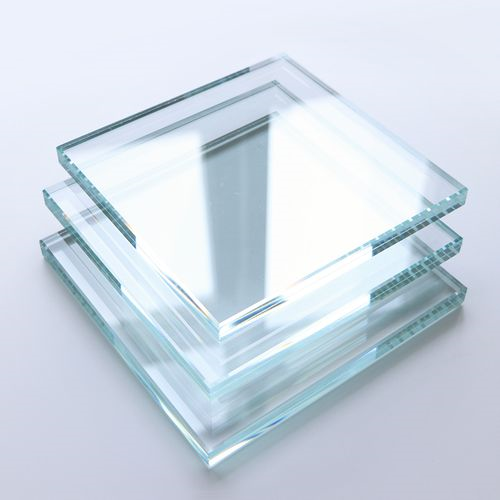Types and properties of Glass
Definitions of Glass
Glass is, from a thermodynamic point of view, a supercooled liquid, i.e., a molten liquid cooled at a rate sufficiently rapid to fix the random microscopic organization of a liquid and avoid the crystallization process to operate. Therefore, by contrast with crystallized solids, glasses do not exhibit a clear melting temperature and the structural change is only reported by an inflection in the temperature-time curve. This change is called the glass transition temperature. As a general rule, glasses are amorphous inorganic solids usually made of silicates, but other inorganic or organic compounds can exhibit a vitreous structure (e.g., sulfides, polymers).

As a general rule, commercial glasses are hard but both brittle and thermal-shock-sensitive materials, excellent electrical insulators, optically transparent media, and exhibit for certain particular chemical compositions (e.g., Vycor® and borosilicated glasses, such as Pyrex®) an excellent corrosion resistance to a wide range of chemicals except hydrofluoric acid, ammonium fluoride, and strong alkali-metal hydroxides and other strong alkalis. Owing to their good transmission in the visible range, glasses are extensively used for optical lenses, sight lenses, and windows. while corrosion-resistant glasses are widely used for cookware and laboratory glassware.
The basic components of silicate glasses are silica, SiO2 (e.g., from siliceous sand), lime, CaO (i.e., from fired limestone, CaCO3), and soda, Na2O (i.e., from soda ash, Na2CO3). Other oxides are used for special purposes such as boric acid (B2O3), potash (K2O), baria (BaO), and lithia (Li2O), while colored glasses require minute additions of transition-metal oxides (e.g., FeO, Co2O3).
Silicate glasses can be grouped into the following categories: A-glass (i.e., high alkali or soda-lime), C-glass (i.e., chemical resistant), E-glass (i.e., calcium alumino borosilicate or borosilicated glasses), and S-glass (i.e., high strength magnesium alumino silicate).
Glassmaking Processes
Float glass (annealed glass)
Historically, two techniques were used to produce sheets of glass. Flat glass was obtained by extruding and rolling a softened mass of glass, while cylinder glass was obtained by blowing molten glass into a cylindrical iron mold. The ends were cut and removed while a cut was made on the overall length of the cylinder. The cut cylinder was then placed in an oven, where the cylinder bent flat into a glass sheet. In both processes, from an optical point of view, the surfaces were rarely parallel, leading to optical distortions.
By contrast, today 90% of the flat glass produced worldwide is obtained by the float glass process invented in the 1950s by Sir Alastair Pilkington of Pilkington Glass Co. In the float glass process, molten glass exiting a melting furnace is poured onto a bath of molten tin metal. The glass floats on the specular surface of the molten tin and levels out as it spreads along the bath, providing a smooth finish on both sides. The glass cools and slowly solidifies as it travels over the molten tin and leaves the tin bath in a continuous ribbon. The glass is then fire-polished. The finished product has near-perfect parallel surfaces.The only drawback of annealed glass is that upon mechanical stress it breaks into large and sharp pieces that can cause serious injury. For that reason, building codes worldwide prohibit the use of annealed glass where there is a high risk of breakage and injury.
Tempered glass (toughened glass, safety glass)
Tempered glass is obtained after applying a thermal tempering process to annealed glass. The glass is cut to the required size and any required processing such as polishing or drilling is carried out before the tempering process begins. The hot glass at 600°C coming from an annealing furnace is placed onto a roller table. The glass is then quenched with forced cold air convection. This rapidly cools the glass surface below its annealing point, causing it to harden and contract, while the inner core of the glass remains free to flow for a short time. The final contraction of the inner layer induces compressive stresses in the surface of the glass balanced by tensile stresses in the body of the glass. This typical pattern of cooling can be observed under polarized light.
Tempered glass exhibits typically a mechanical strength six times that of annealed glass and hence it is also called toughened glass. However, this increased mechanical strength has a drawback. Due to the balanced stresses in the glass, any damage to the glass edges will result in the glass shattering into small sized pieces, and for that reason it is also called safety glass under the tradename Securit®. Therefore, the glass must be cut to size before toughening and cannot be reworked once tempered. Moreover, the toughened glass surface is less hard than annealed glass and more prone to scratching.
Laminated glass
This multilayered composite material was first invented in 1903 by the French chemist Edouard Benedictus, who had been inspired by the breaking resistance of a glass flask coated with a layer of cellulose nitrate. Today, laminated glass is currently produced by bonding two or more layers of ordinary annealed glass together with a plastic interlayer of polyvinyl butyral (PVB). The polymer is sandwiched by the glass, which is then heated to around 70°C and passed through rollers to expel any air pockets and form the initial bond. A typical laminate has a 3-mm layer of glass, 0.38-mm interlayer, and another 3-mm layer of glass. This gives a final product that would be referred to as 6.38 laminated glass. The plastic interlayer keeps the two sheets of glass tightly bound even when broken, and its high strength prevents the glass from breaking up into large sharp pieces. Multiple laminates and thicker glass increase the strength. Bulletproof glass panels, made up of thick glass and several interlayers, can be as thick as 50 mm. The plastic interlayer also gives the glass a much higher acoustic insulation rating due to the damping effect.


